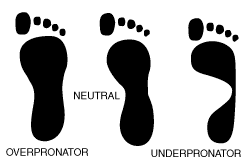Tennis Shoes
Tennis shoes are designed to comfortably endure quick stops and starts. Consult our guide before buying.
How To Buy Tennis Shoes
A good tennis shoe will help you comfortably endure the rigors of the game's quick stops and starts, short sprints and frequent lateral movements. Taking into account your playing style, the type of court on which you typically play and your foot type are essential to making the proper shoe selection.
Durability and sole construction
Tennis is a sport that is rough on shoes, particularly the sole and toe area, so finding a shoe with a sole that is durable enough to meet your particular needs is important. Remember that increased durability often means increased shoe weight, so evaluate your requirements carefully.
Playing style
- Serve and volley player
- Tends to frequently charge the net a lot
- Tends to slide back foot along the court during the serve, so a shoe with a durable toecap (also called a reinforced toe) is essential
- A toecap is an extra piece of rubber that is added to the inside of the outsole at the toe area of some tennis shoes to increase their durability
- Baseline player
- Primarily plays along back line of the court
- Shoes need a lot of lateral support to handle constant sideways motion
- Also needs a shoe with a highly durable sole
Court type
- Hard court
- When playing on a hard court, look for shoes with more durable soles
- Clay/Grass
- Softer surfaces are more forgiving on shoes, so your durability requirements aren't as great
Determining your foot type
When buying tennis shoes, determining your foot type is very important to help you determine how much lateral support and cushioning you will need.
Three basic foot types
There are three basic foot types: supinated, pronated, and neutral.
- Supinated
- If your feet are supinated, the soles of your shoes will tend to wear most on the outside of the heel and the forefoot
- About 30% of the population have supinated feet
- Pronated
- If your feet are pronated, your shoes will tend to wear most on the inside of the forefoot area
- Many types of overuse injuries are associated with this foot type
- About 60% of the population have pronated feet
- Neutral/Ideal
- If you have neutral/ideal feet, your shoes will wear fairly evenly
- Only about 10% of the population has neutral/ideal feet
The "wet test"
If you are unsure of your foot type, the "wet test" will help you determine it.
- Get your foot wet
- Then step on a surface, such as a sidewalk or a piece of dark construction paper. This will show an imprint of your foot.
- The characteristics of the imprint will determine your foot type
- Supinated/Under Pronated
- Your feet are supinated if there is a large open area on the imprint where the arch of your foot didn't touch the ground
- Over Pronated
- Your feet are pronated if a complete impression of your foot can be seen
- Neutral/Ideal
- Your feet are Neutral/Iideal if a moderate space is visible in the arch area

Lateral support
The quick side-to-side moves in tennis make lateral support and the prevention of ankle rollover a major factor in shoe selection for all players.
Special considerations
- Player size
- If you are physically big, lateral support is more important to help you with balance
- Foot type
- If your feet are pronated, lateral support is more important because it helps to take strain off your ankles and knees
Characteristics
- A relatively wide, stable outsole with a flat bottom and tread pattern
- A sturdy upper (leather or leather/nylon combinations are most common) that can hold the foot snugly in place
- A good lacing system will hold your foot snugly in place and won't loosen or require frequent re-tying due to repeated side-to-side movement
- Consider a higher cut shoe if you are especially prone to ankle rollover
Shock absorption and cushioning
With its quick stops and starts, tennis can be jarring to the body. Finding a shoe with proper cushioning and shock absorption is essential for comfort for all players.
Special considerations
- Playing style
- Baseline players typically need more cushioning than serve-and-volley players
- Court type
- Hard-court players will need more cushioning and shock absorption than soft-court players
- Foot type
- If your feet are supinated, shock absorption and cushioning are very important
Cushioning materials
- EVA
- Offers lightweight cushioning, but not as much stability and durability
- Polyurethane (PU)
- A more dense and durable cushioning material that offers increased stability, but is also heavier
Flexibility
- Tennis players require shoes that flex easily at the ball of the foot, its natural bending point
- Proper flexibility allows for the best traction and the most power in each stride
- A shoe that flexes too far back won't perform as well or feel as comfortable
Determining your shoe size
- Determining your proper shoe size is essential to a comfortable fit
- Don't assume your shoe size is the same as it always has been. The shape of your feet changes over time.
Fit Tip
